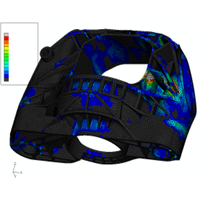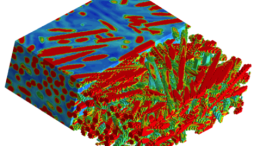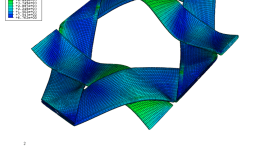
Stiffness and Strength properties for Structural Engineering applications
Strength, rigidity and endurance of any structural components are essential qualities to acquire or maintain a good brand image among consumers. Oversizing is no longer an acceptable solution to achieve the objectives of perceived quality, cost reduction and environmental regulations.
Design structural parts with in depth knowledge about composite materials specificities
The choice of technology of composite materials combined with numerical simulation allows to optimize the structures with respect to these objectives in the best delay. One of the challenges for designers during the simulation is to take into account the specificity of these materials, i.e. their anisotropic behavior, resistance to fracture and their specific mechanism of damage.
Digimat offers the possibility to build and integrate predictive models based on the micro-structure of the material into current calculation workflows to best describe their physicality. These models take into account the influence of the manufacturing process on the local mechanical behavior and stiffness. Digimat also offers capabilities on creating material models for progressive failure analysis. The architecture of the composite can then be considered as an optimization parameter of each component of the structure.
Fiber reinforced plastic becomes major material for intake manifold because of lightweight and heat resisting properties. Detecting the correct high stress concentration area is important to predict fatigue properties of manifold. Digimat helps us to predict correct stress distribution by taking into account the fiber orientation coming from injection molding.
-Noriyo Ichinose, Sales engineer
JSOL Corporation, Japan
Application for Stiffness and Strength in the industry with Digimat modeling plateform:
- Aerospace:
Wings, panels, engine blades, nacelles, interior component, virtual material testing, etc. - Automotive:
Chassis, wheels, connecting rods, full body systems, door, seat, dashboard, interior component, drivetrain component, underhood, oil cooler bracket, front-end carrier, virtual material testing, etc. - Biomedical:
Prosthesis, implants, etc. - Energy:
Pipes, vessel, valves, fan blade, wind turbines blade, pump body, etc. - Electronics:
Connectors, clips, electronic racks and housing assemblies,etc.
| Industries:
Automotive Material:Short fiber reinforced plastic Overview:This new engine mount, nowadays in cars on the road and initially made in metal, has been designed in short fiber reinforced plastic. The simulation has been addressed taking into account the heterogeneous field of fiber orientation. Digimat's technology has allowed to define an optimized lightweight shape respecting the different objectives in terms of stiffness, strength and lifetime performances with a good level of correlation compared to the experimental tests. A total mass of 710g, which represents 40% of its initial weight, has been saved with in addition a reduction of cost of 15%. |
  DOWNLOAD DOWNLOAD |




